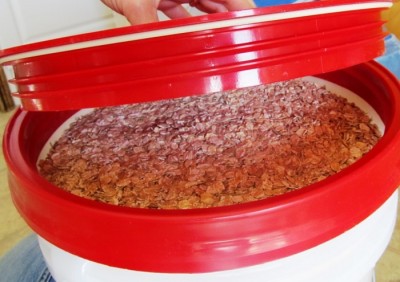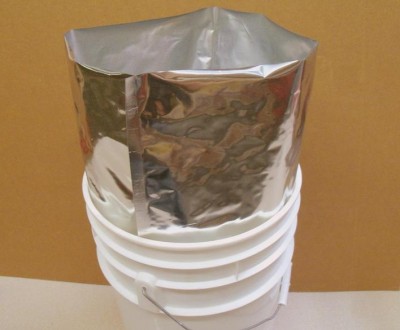Stockpiling food isn’t as simple as it may seem. Oh, you can go buy a couple of 50-pound bags of rice and beans and a few cases of canned goods and think you’re stockpiling, but it won’t be long before you realize that you need to do more than that. Unless you like a diet of pure rice and beans, you’re not going to be happy eating it. On top of that, you’re going to find that there are lots of other critters out there who like your rice and beans just as much as you do.
Developing a survival eating plan for a disaster or crisis scenario is a complicated undertaking. The easiest way is to develop a two-, three- or four-week menu and then multiply the ingredients to make that menu, and then store them. Of course, you have to make sure that the foods used in that menu will store for 20 years, without refrigeration — and that’s where your troubles begin.
There is little that comes prepackaged in such a way that it will last more than a few months or maybe a year on your pantry shelf. Food producers assume that their products will be eaten quickly, often within days of purchase. So they invest just enough in their packaging to ensure that their products will last a few months, and nothing more.
Canned Food
There is one exception to this, and that’s canned goods. While every can of food that I’ve ever looked at has an expiration date printed somewhere on it, that expiration date really doesn’t mean much. The process of canning ensures that foods will last pretty much indefinitely, regardless of what those expiration dates say. Yet, food processing plants add those dates — not to protect the consumer, but to protect themselves from lawsuits.
Metal cans and glass jars are airtight, so anything that’s canned in them will last a long time. But there are some foods which are canned in plastic bottles and jars, such as juices and apple sauce. Those bottles and jars may seem airtight, but they aren’t completely so. Therefore, the expiration dates on those containers does actually mean something. In those cases, you should rotate the stock to ensure that the food you are storing is always fresh and edible.
Dry Foods
But what about everything else? It’s great that canned foods will last virtually forever, but unless you want to live off a diet of fruits, vegetables and condiments, with an occasional can of tuna or chicken thrown in there, you need a more complete diet. That means finding a way of storing dry foods for long-term storage.
This Healthy Survival Food Will Store For YEARS and YEARS!
Dry foods are important, because they are our most common source of carbohydrates. Yes, we can get carbs from fruits and vegetables, but that’s actually much more expensive than getting them from grains. In addition, dried beans are the most common non-meat source of protein, so it’s a good idea to stock plenty of them.
There has been some experimentation done with what is known as the “dry canning method.” This allows canning these dry foods in ordinary canning jars, using the oven, rather than a water bath. While the idea is theoretically sound, it hasn’t been around long enough for anyone to say with certainty whether it will work as a long-term food storage method. It’s just a guess, but I think they’ll find that it works great for some foods, but not for others. Foods that are susceptible to oxidation will probably have the biggest problem.
But there is a way of packaging dry foods for long-term storage, which has been tested and is known to work. This method combines plastic containers with aluminized Mylar bags, while removing oxygen from the package.
In case you’re not sure what aluminized Mylar is, it’s the stuff that they make the printed balloons out of that you see in the grocery store. If you’ve ever bought one, you might have noticed that they hold in the helium much better than rubber balloons, even high quality rubber balloons. That’s because they are more airtight.
Some food packagers have begun packaging their foods in these types of bags, especially for foods like crackers and cookies that go stale quickly. The aluminized Mylar keeps these foods fresh for much longer than any other packaging that has been used in the past.
How to Do it
In order to package your foods in this manner, you’re going to need several things, all of which are fairly easy to obtain:
- Five gallon buckets (food safe ones; they are white)
- Six gallon aluminized Mylar bags (you can buy these online)
- Oxygen absorbers (you can also buy these online)
- A vacuum cleaner with a hose
- A hair straightener or clothes iron (the hair straightener is much easier to work with)
- A rubber mallet
- A large permanent marker
There is one slightly tricky part to storing food in this manner; that’s the issue of the oxygen absorbers. These are very fast-acting. So, when you open the package, you want to use them quickly. With that in mind, you want to make sure that you’re ready to package a bunch of food at the same time, so that you can use all the oxygen absorbers you buy and not save them for another time (they won’t save).
You can buy a plastic clip to seal the bag the oxygen absorbers come in. While that won’t work for any prolonged period of time, it’s worth getting for use while you are sealing the food bags. Closing and sealing the bag between extracting oxygen absorbers will help keep them fresher.
Make ‘Off-The-Grid’ Super Foods Just Like Grandma Made!
I usually wait until I have enough food to fill 10 to 15 five-gallon buckets and package it all at once. That way, I can buy a package of oxygen absorbers to fulfill the need and not have any left over.
In order to package the food:
- Open up the aluminized Mylar bags and place them inside the buckets.
- Fill the bags with food, up to about one inch below the rim of the buckets. It is best to only put in one type of food per bucket. If you want to mix foods, then make sure you have an inventory for each bucket.
- Use the marker to label each bucket with its contents, before you close them up and forget what’s inside.
- Warm up the hair straightener and use it to seal the top edge of the bag closed, but only most of the way. Leave enough room at the end to allow the introduction of the vacuum cleaner hose.
- At this point you’re going to need to move quickly. I recommend having at least one assistant, who is in charge of the oxygen absorbers. That way, he or she can reseal the bag when not being used. Have this person put an oxygen absorber in the bag.
- Once the oxygen absorber is in with the food, put the vacuum cleaner hose in the opening in the bag and suck out excess air. Be careful to only put it in a little, so that you don’t suck out the food that you’ve put in the bag.
- Remove the vacuum cleaner hose and seal the opening in the bag with the hair straightener.
- Fold the edge of the bag down into the bucket and put the lid on, hitting it all around the edge to make it seal.
Dry foods stored in this manner are protected from oxidation, insects and rodents. Even if there are insect eggs in the food, the insects won’t survive without oxygen. You can count on that food being as good to eat 10 or 20 years from now, as when you first purchased it.
During a crisis, if you need to use some of the food that you have stored in this manner, you can take out a quantity of the food and reseal the bag, keeping the rest of it fresh until needed. While it won’t stay as fresh without another oxygen absorber, it will stay considerably fresher than it would being exposed to the open air.
What advice would you add? Do you have any tricks on making food last 20 or more years? Share your advice in the section below:
Discover The Trick To Saving Thousands At The Grocery Store. Read More Here.
 Off The Grid News Better Ideas For Off The Grid Living
Off The Grid News Better Ideas For Off The Grid Living






